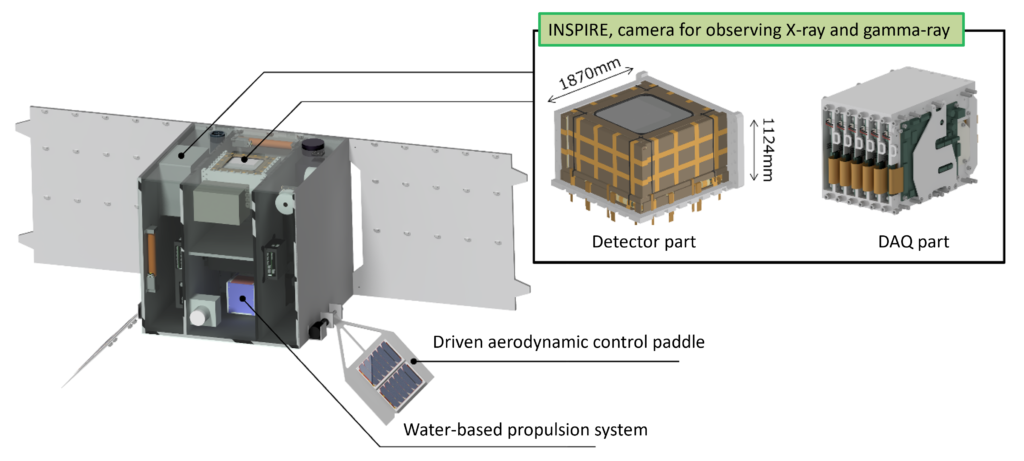Pale Blue to supply its product to Science Tokyo and Waseda University, to expand industry-government-academia collaboration
CHIBA, Japan – Pale Blue is excited to announce the company was awarded a new contract with Science Tokyo and Waseda University to provide the electrical model of the water-based propulsion system, and has launched collaboration for the GRAPHIUM, a microsatellite mission. The satellites will be equipped with the INSPIRE, a small, highly sensitive gamma-ray observation device to monitor the entire sky, while the satellites are planned to demonstrate formation flying by atmospheric force as the sub-mission. Pale Blue’s water-based propulsion systems are also considered using for the formation flying. Going forward, the company will continue to strengthen the collaboration with universities and research institutes.

GRAPHIUM
Overview of the microsatellite, GRAPHIUM
There are approximately 300 known elements on Earth, but where in the universe, rare metals, such as gold and platinum, come from is still a mystery. The most likely scenario is the phenomenon known as a “kilonova,” which is thought to be the explosion of a neutron star merger. Although it is impossible to predict when and where kilonovas will occur in the universe, they are expected to emit X-rays and gamma rays, which are characteristic of gold and platinum. Conventional gamma-ray observations, however, have been performed by large US and European satellites weighing several tons or more, which have a narrow field of view and are not suitable for observing transient events such as kilonovas.
The primary goal of the GRAPHIUM mission is to observe such transient events in gamma rays and to explore the origin of rare metals in the universe. It is equipped with a wide-field, high-sensitivity X-ray gamma-ray camera, INSPIRE, which monitors a quarter of the sky at a time. Despite its weight of 50 kg, the satellite has better performance compared to larger satellites. In addition, the satellite will carry out technology demonstrations for future space technology as a sub-mission. The GRAPHIUM will demonstrate formation flying that actively utilizes the aerodynamic force, with a supportive use of environmentally friendly water-based propulsion as its control engine.
The development of the GRAPHIUM satellite is part of the JST ERATO “Kataoka Line X-ray Gamma-ray Imaging” project. This project aims to create a new academic trend from space to medicine through the imaging technology and concept of line X-ray gamma rays, which have element-specific colors.
Comment from Kei Watanabe, Assistant Professor, Institute of Integrated Research, Quantum Navigation Research Center, Science Tokyo
We have demonstrated the variable shape control of a satellite in orbit with the HIBARI mission and are now trying to apply it to aerodynamic orbit control, which will allow low resource, low cost demonstration of formation flying using water-based propulsion and aerodynamics. It is hoped that this will lower the barrier to orbit control for nanosatellites and further diversify future microsatellite missions.
Comment from Toshihiro Chujo, Associate Professor, School of Engineering Department of Mechanical Engineering, Science Tokyo
GRAPHIUM is designed to carry out missions that are substantial for a microsatellite, both in terms of science and engineering. Among them, formation flying experiments used to be challenging because of the need for a propulsion system, but thanks to the development of water-based propulsion technology, they can now be performed on microsatellites. Orbit control combined with aerodynamics is an interesting experiment from an engineering point of view, and I look forward to realizing it.
Comment from Jun Kataoka, Professor, Faculty of Science and Engineering, Waseda University
Space science has evolved through the development of larger satellites, but at the same time it is gradually losing the light-footwork and flexibility of exploration that science should have. GRAPHIUM is a unique project that uses small satellites as the basis for cutting-edge science and space technology, and is expected to become one the best models for the future.
Comment from Jun Asakawa, Co-Founder and CEO of Pale Blue
GRAPHIUM, which opens up new worlds of advanced science and space engineering, has a strong affinity with our mission to “create mobility that is core to the space industry,” and we are very pleased to be working with them. We will accelerate innovations by strengthening cooperation with universities and research institutes to contribute to the further development of small satellite technologies and the stimulation of the space business.
About Pale Blue
Pale Blue offers water-based propulsion systems suited for a wide variety of missions for spacecraft ranging from 3U Cubesats to 700 kg satellites. Founded by four propulsion experts from the University of Tokyo in 2020, the company has developed a series of electric propulsions and supplied to partners globally. Through its innovative propulsion technologies, Pale Blue enables in-space mobility that is core to the space industry.
Contact
Pale Blue Inc.
pr@pale-blue.co.jp
